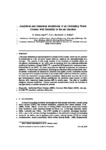Analytical and numerical simulations of an oscillating water column with humidity in the air chamber
| dc.contributor.author | Medina-Lopez, E | |
| dc.contributor.author | Borthwick, Alistair | |
| dc.contributor.author | Moñino, A | |
| dc.date.accessioned | 2021-08-22T12:42:23Z | |
| dc.date.available | 2021-08-22T12:42:23Z | |
| dc.date.issued | 2019-11 | |
| dc.identifier.issn | 0959-6526 | |
| dc.identifier.other | 117898 | |
| dc.identifier.uri | http://hdl.handle.net/10026.1/17675 | |
| dc.description.abstract |
This paper examines an Oscillating Water Column (OWC) model, where the air chamber is represented as a dry air–water vapour mixture, based on the thermodynamics of a real gas. The novelty of this study consists of the inclusion of humidity effects on the general performance of the OWC and its coupling with the radiation–diffraction problem of the device. Using FLUENT®, a numerical 2D flume is built to simulate wave–induced flow in the OWC. Air phase properties are adjusted to represent the presence of moisture. Turbine linear performance, according to a standard Wells turbine power take–off system, is simulated by means of an Actuator Disk Model (ADM). Numerical outputs are compared with analytical solutions of the classic OWC radiation–diffraction problem, in which the theoretical real gas model is embedded. Results show that the use of real gas thermodynamic theory reduces considerably the predicted power output of OWC devices, with theoretical losses reaching 50% in certain cases. The effect of humidity mitigates resonant conditions. Techno–economic considerations justify the inclusion of real gas theory to achieve competitive devices. | |
| dc.format.extent | 117898-117898 | |
| dc.language | en | |
| dc.language.iso | en | |
| dc.publisher | Elsevier BV | |
| dc.title | Analytical and numerical simulations of an oscillating water column with humidity in the air chamber | |
| dc.type | journal-article | |
| dc.type | Journal Article | |
| plymouth.volume | 238 | |
| plymouth.publication-status | Published | |
| plymouth.journal | Journal of Cleaner Production | |
| dc.identifier.doi | 10.1016/j.jclepro.2019.117898 | |
| plymouth.organisational-group | /Plymouth | |
| plymouth.organisational-group | /Plymouth/Faculty of Science and Engineering | |
| plymouth.organisational-group | /Plymouth/Faculty of Science and Engineering/School of Engineering, Computing and Mathematics | |
| plymouth.organisational-group | /Plymouth/Users by role | |
| plymouth.organisational-group | /Plymouth/Users by role/Academics | |
| dc.rights.embargoperiod | Not known | |
| rioxxterms.versionofrecord | 10.1016/j.jclepro.2019.117898 | |
| rioxxterms.licenseref.uri | http://www.rioxx.net/licenses/all-rights-reserved | |
| rioxxterms.type | Journal Article/Review |


